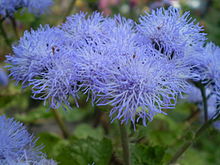- Ageratum houstonianum
-
Flossflower 
Scientific classification Kingdom: Plantae (unranked): Angiosperms (unranked): Eudicots (unranked): Asterids Order: Asterales Family: Asteraceae Tribe: Eupatorieae Genus: Ageratum Species: A. houstonianum Binomial name Ageratum houstonianum
Mill.Ageratum houstonianum (Flossflower, Bluemink, Garden Ageratum, Blueweed, Pussy Foot) syn. Ageratum mexicanum Hort.) is a cool-season annual plant often grown as a bedding plant in gardens. Herb 0.3–1 m high, leaves ovate to triangular 2–7 cm long, and flowers are usually blue (though sometimes white, pink, or purple), the heads borne in dense corymbs. The ray flowers are threadlike, leading to the common name.[1]
Native to Central America and adjacent parts of Mexico, but has become an invasive weed in other areas.[2][3]
Ageratum has evolved an ingenious method of protecting itself from insects; it produces a precocene compound which interferes with the normal function of the corpus allatum, the organ responsible for secreting juvenile hormone. This chemical triggers the next molting cycle to prematurely develop adult structures, and can render most insects sterile if ingested in large enough quantities. [4]
Contents
Varieties
- Ageratum houstonianum var. angustatum B.L. Rob.[5]
- Ageratum houstonianum f. isochroum
- Ageratum houstonianum f. luteum
- Ageratum houstonianum var. muticescens
- Ageratum houstonianum f. niveum
- Ageratum houstonianum f. normale
- Ageratum houstonianum var. typicum
- Ageratum houstonianum f. versicolor
Cultivars
Blue Blazer, Blue Mink, Blue Danube, Blue Horizon, Hawaii.
Toxicity
Ageratum houstonianum is toxic to grazing animals, causing liver lesions.[6][7] It contains pyrrolizidine alkaloids.[8]
Weed risk
A. houstonianum is prone to becoming a rampant environmental weed when grown outside of its natural range. It has become an invasive weed in the eastern USA, Australia, Europe, Africa, China, Japan and New Zealand.[9]
References
- ^ New South Wales Flora Online, Ageratum houstonianum
- ^ "Ageratum houstonianum". Flora of North America. http://www.efloras.org/florataxon.aspx?flora_id=1&taxon_id=200023022.
- ^ Species profile
- ^ I. Kiss et al. (September, 1988), "Biological activity of precocene analogues on Locusta migratoria", Cellular and Molecular Life Sciences 44: 790–792, doi:10.1007/BF01959168
- ^ JSTOR Plant Science
- ^ Acamovic, T., Stewart, C.S., Pennycott, T.W.,"Poisonous Plants and Related Toxins", 2004
- ^ Noa, M., Sanchez, L.M., Durand, R., "Ageratum houstonianum toxicosis in Zebu cattle", Veterinary and human toxicology, 2004, vol.46, no4, pp.193-195.
- ^ Wiedenfeld H, Andrade-Cetto A., "Pyrrolizidine alkaloids from Ageratum houstonianum Mill.", Phytochemistry, 2001 Aug, pp1269-71 [1]
- ^ Global Compendium of Weeds, Ageratum houstonianum (Asteraceae)
- Bailey, L. H. (2005). Manual of Gardening (Second Edition).. Project Gutenberg Literary Archive Foundation. http://www.gutenberg.org/etext/9550.

This Eupatorieae article is a stub. You can help Wikipedia by expanding it.

